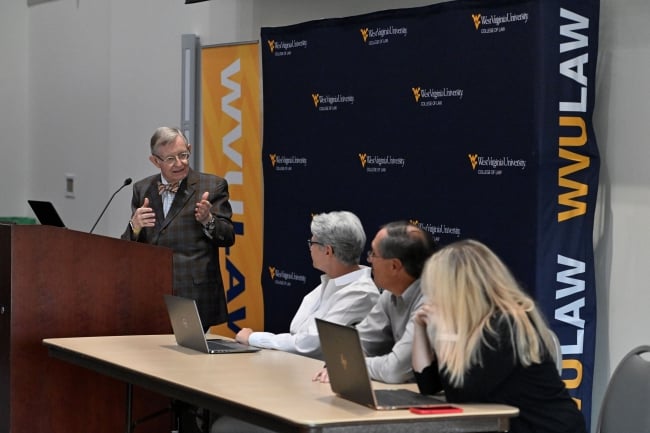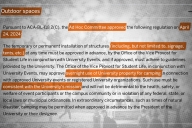You have /5 articles left.
Sign up for a free account or log in.

WVU president Gordon Gee (left) addresses the Faculty Senate at a meeting in September 2022. Gee’s “transformative” restructuring plan includes program cuts and layoffs that have faculty up in arms.
WVU Photo/Jennifer Shephard
When West Virginia University president E. Gordon Gee announced plans to cut programs and faculty in the face of a projected $75 million budget shortfall, he said he wanted the process to be as compassionate and transparent as possible. It was, after all, the first reduction in force (RiF) in the university’s history to include faculty.
That unprecedented step is proving a difficult sell. In an open letter penned last week, 55 faculty members wrote that WVU administrators have been underhanded and inconsistent in their communication about the cuts. Faculty members said they feel both excluded from the process and anxious about its potential scale.
“There’s been no dignity or respect,” said Gwen Bergner, an English professor who signed the letter. “And sure, they’re being transparent about their schedule for firing people. But they’re not really transparent about the budget. They’re not transparent about how this deficit got so large, or how they’re deciding who to lay off.”
Maryanne Reed, provost and vice president for academic affairs, said she understands faculty concerns and hopes that in the coming weeks the university can offer more information and a better sense of the impact of the cuts.
“I recognize that faculty are anxious and worried right now, and I feel for them. There’s a lot of ambiguity we’re dealing with, and uncertainty makes people anxious,” she said. “But while it’s painful, it is unfortunately necessary. And I truly believe that when we’re able to show our metrics and our framework for decision-making, it will become clear that the majority of campus is not going to be impacted by this, which I believe will help quell some of that anxiety and unrest.”
The provost’s office has been gathering data on academic programs, which will be used to determine which ones are “of concern,” according to minutes from the May 8 Faculty Senate meeting; deans and department chairs will be notified which programs are in danger by the week of July 10. Reed said her office will share a “general outline” of the metrics being used in those assessments at an open meeting on June 27.
Bergner, who has taught at WVU since 1996, said she can’t remember another time when the university undertook such drastic cost-cutting measures. She believes the process is being rushed in order to limit opportunities for faculty to voice their concerns on campus before the cuts are announced in October.
“This is going to devastate people’s lives,” she said. “But there’s been no discussion or communication with administrators … It seems like they’ve laid out their process, and now the juggernaut has been launched. It’s full steam ahead, and people are scared.”
“We are operating on a fairly accelerated timeline, because our board is expecting us to make decisions that will impact the fiscal year 2025 budget,” Reed said. “Within that time frame, however, we are looking for every opportunity that is available to engage our faculty and our staff in the process.”
Tom Harnisch, vice president for government affairs at the State Higher Education Executive Officers Association, said that while WVU should aim for maximum transparency about the layoffs, the cost-cutting process itself has become almost inevitable for public universities in the face of declining enrollments and stagnant state investment.
“WVU is certainly not the first university to have this conversation about program offerings and what makes sense regarding student demands … They usually happen at regional universities, but there are other flagships in areas with demographic issues having the same hard conversations,” he said, citing the University of Maine and the University of Kansas, two flagships in states with similarly plummeting birth rates.
Hard Realities or Convenient Excuses?
WVU administrators have been selling the reduction in force (RiF) not as an unfortunate necessity, but as a canny pivot toward a leaner future. That narrative has been difficult for many faculty to accept.
At the May 8 Faculty Senate meeting, Gee laid out his underlying reasons for the proposed strategic cutbacks, including the significant reduction in faculty and staff numbers. He listed the usual suspects: the approaching demographic cliff, diminishing state support, persistent inflation and rising college dropout rates.
But the most damaging force, he said, was academia’s own intransigence.
“Higher education has lost the support and trust of the American public. It is that simple,” he said. “We are our own worst enemy in that regard. I want to be very blunt: we have been isolated, we have been arrogant, we have told the American public what they should think … we have to turn that around almost immediately, otherwise we have a very bleak future indeed.”
The cure for this loss of enthusiasm, Gee continued, is to recommit to student success above all else—to reaffirm WVU’s land-grant mission, “which we’ve drifted away from.” In terms of programmatic restructuring, Gee said WVU must “differentiate” itself by bolstering its distinct offerings and paring down everything else.
Many WVU faculty members believe Gee’s diagnosis is dishonest and worry his prescriptions could do more harm than good.
“For President Gee to blame faculty for this, it adds insult to injury, but it’s also just disingenuous,” Bergner said. “I understand there’s a budget crisis, but you can’t say responding to that is going to make us more student-centered or mission-oriented … You can say it’s an unavoidable tragedy and will hurt those things, but you can’t paint it as enhancing them.”
A spokesperson for the university said Gee’s schedule precluded him from speaking with Inside Higher Ed.
Kelly Allen, executive director of the nonprofit West Virginia Center on Budget and Policy, said Gee’s rhetoric is eerily similar to that used by Republican state lawmakers in discussing the need for funding cuts.
“This is a trend we have been seeing in public education as well: enrollment is declining as our state population is declining, and so it’s fine—or even better—for schools to make do with less,” she said. “That’s really a convenient excuse and maybe even a way for some folks to escape accountability.”
Tenure in a Tenuous State
One major concern of WVU faculty members is the recent, and potentially ongoing, changes to tenure protections. They stem from a 2018 rule change adopted by WVU’s Board of Governors, which holds that tenure protections don’t apply in the event of financial exigency or a reduction in force. The provost’s office sent an email Wednesday notifying faculty that their annual letters of appointment would come early this year—but could also potentially include notices of termination for tenured or tenure-track faculty.
The stipulation shocked many professors; Bergner said she hadn’t even been aware of the board change, called Rule 4.7, until the RiF was announced this spring. She said treating tenure as a fungible amenity vulnerable to suspension in times of crisis undermines its inherent value.
“I don’t even know how this rule got passed so quietly,” she said. “It’s a draconian measure that’s going to damage our ability to succeed. You can’t be a competitive R-1 institution if you don’t have tenure.”
An update posted to WVU’s “Transformation” webpage said that Rule 4.7 “does not eliminate the promotion and tenure system or undermine academic freedom” and only alters them in “limited circumstances,” such as the current budget shortfall and RiF.
Reed reiterated that WVU was committed to protecting tenure but added that it shouldn’t be considered an impenetrable shield in times of necessary financial paring.
“I’m a tenured faculty member; I respect tenure greatly. But it’s not a lifetime job guarantee,” she said. “If we’re reducing or eliminating programs, we should look at the very best faculty who are here to teach our students and do the work. Some of those may be tenured; some may not be.”
At the very least, Bergner said, the emergency suspension of tenure casts a dire light on WVU’s situation, which, for many faculty members, made Gee’s positive spin a bitter pill to swallow.
“If you become an institution of people on two-year contracts, you just don’t have the stability to build programs or do groundbreaking research or mentor grad students,” she said. “It does not feel like this is WVU righting the ship; it feels like the basic functioning of the university is at stake.”
‘Penny-Wise and Pound-Foolish’
Neither Gee nor Reed placed much emphasis on the role of state disinvestment in creating WVU’s budget problems, an omission that Allen said was curious. West Virginia’s state funding for higher education has decreased by over 25 percent in the past decade, according to a Center for Budget and Policy study.
“They are truly selling state disinvestment short; that’s the primary reason for these budget shortfalls, not these universal problems,” Allen said. “Couching the cuts in this rhetoric about the arrogance of academics is odd and really reflective of how state lawmakers think … I worry higher ed leaders are falling into the same trap as lawmakers: being penny-wise and pound-foolish.”
WVU’s enrollment decline has been far worse than the national average, falling 10 percent since 2015. Amy Weislogel, a professor of geology and geography who signed the open letter, said that the enrollment drop probably has a lot more to do with the reduction in state financial aid and program funding than with demographic trends.
“We’ve been doing more with less for 10 years now,” Weislogel said “We’ve cut through the flesh and close to the bone in a lot of our programs, and we lost great people as a result … Now, we apparently don’t even have the resources to sustain that anymore.”
Harnisch said that those long-term effects were certainly valid concerns, and recruitment may well become more difficult for WVU. But he added that dealing with a dire budget shortfall is difficult, and it may be better to bite the bullet than wait for the wound to fester.
“I think they’re being smart in taking this head-on, accepting the financial and demographic realities in the state and making the changes necessary to make sure that the university thrives,” he said. “It’s better than putting it off and waiting for the problem to get worse.”









